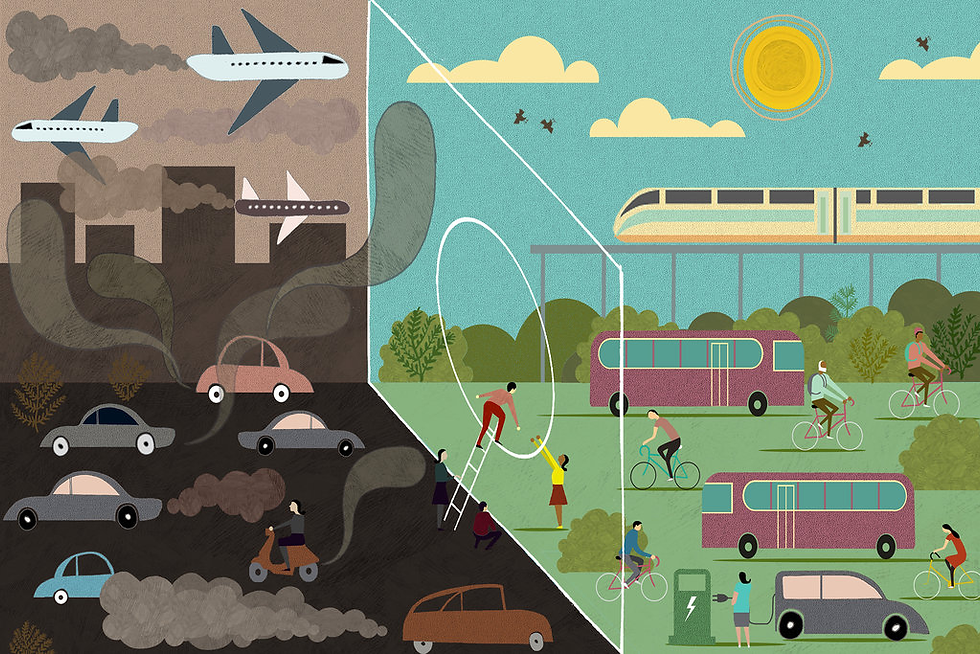How to Reduce Your Carbon Footprint
- Gur So
- Dec 4, 2022
- 3 min read
Climate change can be overwhelming. The science is complex, and when it comes to future impacts, there are still a lot of unknowns. While real solutions will require action on a global scale, there are choices you can make in your day-to-day life to lessen your personal impact on the environment. This guide will walk you through some of them.
What Is a Carbon Footprint?

A carbon footprint is the total amount of greenhouse gas emissions that come from the production, use and end-of-life of a product or service. It includes carbon dioxide — the gas most commonly emitted by humans — and others, including methane, nitrous oxide, and fluorinated gases, which trap heat in the atmosphere, causing global warming. Usually, the bulk of an individual’s carbon footprint will come from transportation, housing and food.
You can start the process by calculating your carbon footprint here. You will need to know the following:
Approximately how many miles you travel by car, bus, train and plane.
The energy usage in your home.
How much you spend shopping.
The composition of your diet.
No matter how you scored, here are some things that could help you lessen your personal environmental impact.
On the Road, in the Sky One of the most effective ways to begin thinking about how to reduce your carbon footprint is to reconsider how much, and how often, you travel.

Drive Less
In November 2017 carbon dioxide emissions from transportation surpassed emissions from electricity generation as the top source of greenhouse gases. Why? Electricity generation is shifting away from the use of coal to more renewable sources and natural gas.
Going carless for a year could save about 2.6 tons of carbon dioxide, according to 2017 study from researchers at Lund University and the University of British Columbia — that’s a little more than a roundtrip transatlantic flight. How can you stop using a car? Try taking a train, bus or better yet, ride a bike.
But let’s be realistic. You will likely need to use a car this year. So, when you do, here are some tips to make your trip more climate-friendly:
Go easy on the gas and brakes — driving efficiently can help to reduce emissions. Drive “like you have an egg under your foot,” recommends Brian West, an expert in fuel and engine research from the Oak Ridge National Laboratory, which researches energy use and solutions in the United States.
Regularly service your car to keep it more efficient.
Check your tires. Keeping tires pumped correctly can reduce emissions. “Low tire pressure will hurt your fuel economy,” Mr. West said.
Air conditioning and intensive city driving can make emissions creep up. Cut down on these as often as possible.
Use cruise control on long drives — in most cases, this can help to save gas.
Don’t weigh your car down with extra things that you don’t need on your trip.
Carpool — this way, you’re splitting emissions between the number of people in the car.
Buying a New Car?
Shopping for a new car is a great opportunity to consider how you can reduce your personal carbon footprint. When choosing between gasoline, hybrid and electric, there are a number of factors to take into account, which will determine how “clean” your purchase is. The following can help:
Search for cars here, where they are rated by efficiency.
Think about where you will be charging up. How efficient hybrid and electric cars are also depends on what state you live in — different states rely on fossil fuels to different degrees.
Weigh up both production and use emissions using this app. (Making electric cars has a carbon footprint, too.)
Look for the Smart Way certification.
Remember: Cars with lower emissions can often end up costing less to operate.
Fly Less Fly often? Taking one fewer long round-trip flight could shrink your personal carbon footprint significantly. Think about it this way: If you use public transportation often, and fly home to visit family just occasionally, your carbon footprint might still be relatively sustainable, but if you drive and fly a lot, your emissions will be higher. If you can’t avoid flying, one way of making up for the emissions caused is to offset them by donating money to sustainable projects, such as supplying efficient stoves to rural homes, or projects which help farmers in India sell crop waste as biomass. Sometimes airlines will give you this option themselves, or you can use a third-party like Atmosfair or Terrapass. (You can calculate the emissions per flight here.)




Comments